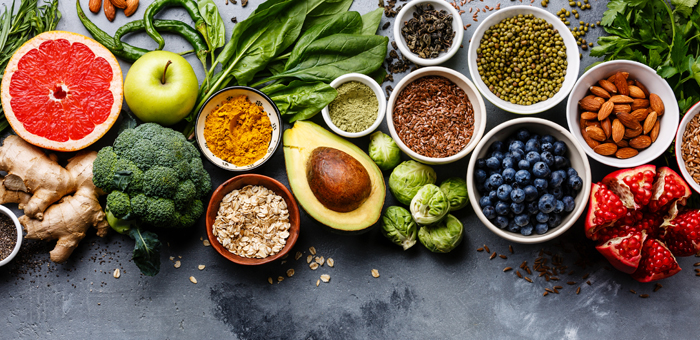Step Out of the Menu Rut

When you first start on the healthy eating path everything seems new and exciting. You are opened up to new tastes, flavours and textures. Some you love, some you hate, some you acquire a taste for over time. But, as time goes on, you get stuck in rut. You have the same meals week after week. Boredom with what you eat is a sure fire way to fall off the path and back into old habits. It is, however, completely unnecessary. With a bit of imagination and a willingness to try new things you can keep your meals and snacks fresh and exciting every day.
A good place to start when looking for new foods to plunder is to browse the farmer’s markets and health food shops. See also the blog post on How Umami Affects Food Choices for ideas on how to make your meals more delicious.
Here are some ideas for foods that might not be part a regular feature in your shopping basket:
Vegetables
Cavolo nero (black cabbage), kale, purple sprouting broccoli, beet greens, Swiss chard, endives, chicory, Jerusalem artichokes, globe artichokes, aubergines (eggplants), pak choi (bok choy), Chinese leaves, celeriac, daikon or mouli, kohlrabi, okra, watercress.
Whole grains and flours
Wild rice, red rice, quinoa (red, white or black), millet, buckwheat (toasted or untoasted), amaranth, polenta, rye, pot barley, oatmeal, chickpea flour (gram flour), spelt and kamut (these last two are ancient types of wheat so may not be suitable for people who can’t tolerate wheat or gluten)
Peas, beans and lentils
Red split lentils, split yellow or green peas, aduki beans, borlotti beans, blackeye peas, black turtle beans, butter beans (lima beans), haricot beans (navy beans), cannellini beans, broad beans (fava beans), French beans, runner beans, chickpeas (garbanzo), soy beans (including tempeh, tofu and soy yoghurt), flageolet beans, pinto beans, kidney beans, puy lentils, green lentils, brown lentils, mung beans.
Nuts and seeds
Chia seeds, flax seeds (linseeds), sunflower seeds, sesame seeds, pumpkin seeds, hemp seeds, walnuts, almonds, hazelnuts (filberts/cobnuts), macadamia nuts, Brazil nuts, pecan, cashews, pistachios, pine nuts, chestnuts, coconuts and coconut cream.
Sea vegetables
Arame, dulse, hijiki, kelp, kombu, nori, wakame.
Herbs and spices
Coriander, cumin, cardamom, aniseed, caraway, celery salt, dill, parsley, cayenne pepper, garam Masala, turmeric, ginger, fennel, star anise, bay leaves, basil, lemon grass, mixed spice, allspice, harissa, chervil, chives, fenugreek, thyme, oregano, marjoram, sage, tarragon, cinnamon, cloves, nutmeg, mustard, paprika, mustard, black, white or red pepper corns.
Oils
Coconut oil, toasted sesame oil, olive oil, pumpkin seed oil, walnut oil, hazelnut oil, avocado oil.
Flavourings
Miso (there are many different types so experiment – the lighter coloured ones are sweeter and milder), tamari soy sauce, vegetable bouillon or stock cubes, curry powder, sea salt or rock salt, garlic.
Don’t be afraid to be experimental with your cooking.
- Many vegetables can be chopped up and added to soups, stews and casseroles or just steamed as a side dish.
- Most grains can be cooked in twice the amount of water until all the water has been absorbed – herbs, spices and flavourings can be added to these during cooking.
- Beans and lentils can be used to form the base of a soup, stew, casserole or salad or whizzed up into a dip with some tahini, tamari and lemon juice.
- Nuts and seeds can be added raw or lightly toasted to salads or stir fries.
- Herbs and spices can be used as you wish for adding heat or depth to foods – the more you use these the more you’ll understand which flavours works well together.
- Nut and seed butters can be stirred into porridge, muesli, sauces, soups and stews to add depth of flavour.
- Creamed coconut works well in curries, soups and desserts adding a rich, sweet creaminess.
- Different oils can jazz up salads and can be sprinkled onto cooked vegetables and grains.
- Miso and tamari can add umami and saltiness to savoury dishes.
It doesn’t matter if you make some mistakes along the way. Most things will be perfectly edible and you can improve on them next time. Aim to learn one new recipe each week to add to your repertoire. Exchange recipes with friends and encourage other members of the family to choose meals and foods to cook.